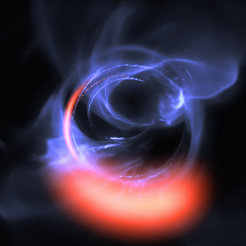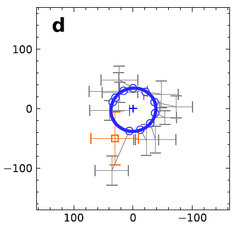First Detailed Observations of Material Orbiting close to a Black Hole
GRAVITY instrument confirms black hole status of the Milky Way centre

In a paper published on 31 October 2018 in the journal Astronomy & Astrophysics, scientists from a consortium of institutions, the Max Planck Institute for Extraterrestrial Physics (MPE), Observatories of Paris and Grenoble, University of Cologne, Max Planck Institute for Astronomy, and Universities of Lisbon and Porto, working with ESO’s GRAVITY-VLTI reported the observation of flares of infrared radiation coming from the accretion disk of Sagittarius A*, a belt of gas with about 10 light-minutes in diameter orbiting at relativistic speeds. While some matter can orbit the black hole safely, anything that gets too close is doomed to be pulled beyond the event horizon. The observed flares originated from material orbiting very close to the event horizon of Sagittarius A* itself.
“It is mind boggling to actually witness material orbiting a massive black hole at 30% of the speed of light,” marvels Oliver Pfuhl, postdoctoral researcher at the MPE. “GRAVITY and its tremendous sensitivity allowed us to observe the accretion processes in real-time at unprecedented detail."
Already earlier this year, the 10 to 20 times greater angular resolution and astrometric measurement precision of GRAVITY, together with precision spectroscopy with the SINFONI integral field instrument on the VLT, have allowed the same team to accurately measure the close fly-by of the star S2 near the massive black hole candidate Sagittarius A*. Analysing this orbital motion, the scientists detected first order deviations from Newtonian dynamics as predicted by General Relativity.

This plot from the original publication shows a comparison of the data with a realization of a simple hot spot model including various effects of General and Special Relativity. The continuous blue curve denotes a hot spot on a circular orbit with 1.17 times the innermost stable circular orbit, i.e. just outside the event horizon, of a 4 million solar mass black hole. The axis give the offset from the centre in micro-arcseconds.
During these measurements the 'GRAVITY Team' also caught strong infrared emission in three prominent bright flares from very energetic electrons much closer to the black hole. This emission is thought to be coming from compact 'magnetic thunderstorms' in the very hot gas orbiting around Sagittarius A*, in analogy to the radiation bursts of solar flares. The motion of the three flares observed in the galactic centre can be explained by a simple orbit model with a radius of three to five times the event horizon. Thus, these observations confirmed exactly the theoretical predictions for such hot spots orbiting at the innermost edge of stable orbits. “Taken together, our observations strongly support the presence of orbiting material very close to the event horizon of a four million solar mass black hole,” sums up Jason Dexter, corresponding author from MPE.
Reinhard Genzel, of the Max Planck Institute for Extraterrestrial Physics (MPE) in Garching, Germany, who led the study, explained: “This always was one of our dream projects but we did not dare to hope that it would become possible, so soon and so clear.” Referring to the belief that Sagittarius A* is a supermassive black hole, Genzel concluded that “the result is a resounding confirmation of the massive black hole paradigm.”
Notes
1. If you have an interview request, please contact the individual scientists by email or the group secretariat at the Max Planck Institute for Extraterrestrial Physics (see contact details in the side bar), as the whole team is at a conference this week. The secretariat will do its best ensure that you get a reply by one of the scientists in a timely fashion.
2. These extremely precise measurements were made by an international team led by Reinhard Genzel (MPE) in Garching, Germany, in conjunction with collaborators around the world, at the Paris Observatory–PSL, the Université Grenoble Alpes, CNRS, the Max Planck Institute for Astronomy, the University of Cologne, the Portuguese CENTRA – Centro de Astrofisica e Gravitação and ESO. The observations are the culmination of a 26-year series of ever-more-precise observations of the centre of the Milky Way using ESO instruments.
The results are presented in a paper by GRAVITY collaboration: R. Abuter (ESO, Garching, Germany), A. Amorim (Universidade de Lisboa, Lisbon, Portugal), M. Bauböck (Max Planck Institute for Extraterrestrial Physics, Garching, Germany [MPE]), J.P. Berger (Univ. Grenoble Alpes, CNRS, IPAG, Grenoble, France [IPAG]; ESO, Garching, Germany), H. Bonnet (ESO, Garching, Germany), W. Brandner (Max Planck Institute for Astronomy, Heidelberg, Germany [MPIA]), Y. Clénet (LESIA, Observatoire de Paris, PSL Research University, CNRS, Sorbonne Universités, UPMC Univ. Paris 06, Univ. Paris Diderot, Meudon, France [LESIA])), V. Coudé du Foresto (LESIA), P. T. de Zeeuw (Sterrewacht Leiden, Leiden University, Leiden, The Netherlands; MPE), C. Deen (MPE), J. Dexter (MPE), G. Duvert (IPAG), A. Eckart (University of Cologne, Cologne, Germany; Max Planck Institute for Radio Astronomy, Bonn, Germany), F. Eisenhauer (MPE), N.M. Förster Schreiber (MPE), P. Garcia (Universidade do Porto, Porto, Portugal; Universidade de Lisboa Lisboa, Portugal), F. Gao (MPE), E. Gendron (LESIA), R. Genzel (MPE; University of California, Berkeley, California, USA), S. Gillessen (MPE), P. Guajardo (ESO, Santiago, Chile), M. Habibi (MPE), X. Haubois (ESO, Santiago, Chile), Th. Henning (MPIA), S. Hippler (MPIA), M. Horrobin (University of Cologne, Cologne, Germany), A. Huber (MPIA), A. Jimenez Rosales (MPE), L. Jocou (IPAG), P. Kervella (LESIA; MPIA), S. Lacour (LESIA), V. Lapeyrère (LESIA), B. Lazareff (IPAG), J.-B. Le Bouquin (IPAG), P. Léna (LESIA), M. Lippa (MPE), T. Ott (MPE), J. Panduro (MPIA), T. Paumard (LESIA), K. Perraut (IPAG), G. Perrin (LESIA), O. Pfuhl (MPE), P.M. Plewa (MPE), S. Rabien (MPE), G. Rodríguez-Coira (LESIA), G. Rousset (LESIA), A. Sternberg (School of Physics and Astronomy, Tel Aviv University, Tel Aviv, Israel, Center for Computational Astrophysics, Flatiron Institute, New York, USA), O. Straub (LESIA), C. Straubmeier (University of Cologne, Cologne, Germany), E. Sturm (MPE), L.J. Tacconi (MPE), F. Vincent (LESIA), S. von Fellenberg (MPE), I. Waisberg (MPE), F. Widmann (MPE), E. Wieprecht (MPE), E. Wiezorrek (MPE), J. Woillez (ESO, Garching, Germany), S. Yazici (MPE; University of Cologne, Cologne, Germany).













